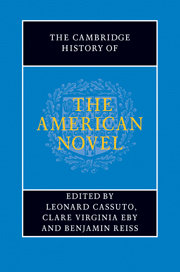Book contents
- Frontmatter
- General Introduction
- PART ONE INVENTING THE AMERICAN NOVEL
- PART TWO REALISM, PROTEST, ACCOMMODATION
- PART THREE MODERNISM AND BEYOND
- Introduction: modernism and beyond
- 37 Stein, Hemingway, and American modernisms
- 38 The Great Gatsby and the 1920s
- 39 Philosophy and the American novel
- 40 Steinbeck and the proletarian novel
- 41 The novel, mass culture, mass media
- 42 Wright, Hurston, and the direction of the African American novel
- 43 Ellison and Baldwin: aesthetics, activism, and the social order
- 44 Religion and the twentieth-century American novel
- 45 Faulkner and the Southern novel
- 46 Law and the American novel
- 47 Twentieth-century publishing and the rise of the paperback
- 48 The novel of crime, mystery, and suspense
- 49 US novels and US wars
- 50 Science fiction
- 51 Female genre fiction in the twentieth century
- 52 Children's novels
- 53 The American novel and the rise of the suburbs
- 54 The Jewish great American novel
- 55 The Beats and the 1960s
- 56 Literary feminisms
- 57 Reimagining genders and sexualities
- PART FOUR CONTEMPORARY FORMATIONS
- A selected bibliography
- Index
47 - Twentieth-century publishing and the rise of the paperback
from PART THREE - MODERNISM AND BEYOND
Published online by Cambridge University Press: 28 July 2011
- Frontmatter
- General Introduction
- PART ONE INVENTING THE AMERICAN NOVEL
- PART TWO REALISM, PROTEST, ACCOMMODATION
- PART THREE MODERNISM AND BEYOND
- Introduction: modernism and beyond
- 37 Stein, Hemingway, and American modernisms
- 38 The Great Gatsby and the 1920s
- 39 Philosophy and the American novel
- 40 Steinbeck and the proletarian novel
- 41 The novel, mass culture, mass media
- 42 Wright, Hurston, and the direction of the African American novel
- 43 Ellison and Baldwin: aesthetics, activism, and the social order
- 44 Religion and the twentieth-century American novel
- 45 Faulkner and the Southern novel
- 46 Law and the American novel
- 47 Twentieth-century publishing and the rise of the paperback
- 48 The novel of crime, mystery, and suspense
- 49 US novels and US wars
- 50 Science fiction
- 51 Female genre fiction in the twentieth century
- 52 Children's novels
- 53 The American novel and the rise of the suburbs
- 54 The Jewish great American novel
- 55 The Beats and the 1960s
- 56 Literary feminisms
- 57 Reimagining genders and sexualities
- PART FOUR CONTEMPORARY FORMATIONS
- A selected bibliography
- Index
Summary
American novelists and their publishers faced a rapidly changing professional situation during the middle decades of the twentieth century, from approximately 1920 to 1970. By the end of the First World War, it had become apparent to US book-publishing houses that they could no longer operate in the nineteenth-century fashion – an approach, developed by leading British firms, that had emphasized low overhead, a limit on new titles, modest advertising, controlled print runs, and distribution through established bookshops. Such strategies had worked reasonably well in the USA during the late 1800s and early 1900s but, by 1920, no longer served the interests of most American publishers. The key issues were distribution and price maintenance: British publishers could market their books through an established network of bookshops and send them virtually anywhere in Great Britain through an efficient railway system; they could also maintain retail prices, and thus avoid price-cutting and loss-leadering, owing to the Net Book Agreement, a measure they had agreed upon in 1899 to create a loose monopoly among themselves over book pricing. British publishers depended on the home island for most of their sales and got rid of slow-selling titles and remaindered stock in the colonial trade. These strategies were effective. The major publishing firms in Great Britain, all of them based either in London or Edinburgh, controlled the book business, kept the booksellers under tight rein, and prospered.
- Type
- Chapter
- Information
- The Cambridge History of the American Novel , pp. 781 - 797Publisher: Cambridge University PressPrint publication year: 2011



